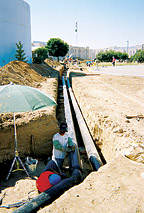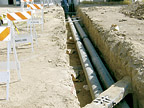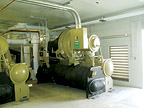
Like most county governments, the County of Kern is suffering from funding and budget issues, prohibiting any capital upgrades with normal budgetary funds. However, the mechanical equipment at Lerdo, including the chilled and domestic water systems, was long past its useful life expectancy, and mechanical failures were costing more money to repair each year. In addition, Lerdo had no EMS at all, so controlling energy usage by the mechanical systems was virtually impossible.
County officials contacted NORESCO of Sacramento to see if the energy services company could suggest ways to implement the desperately needed retrofits. NORESCO engineers formulated a plan by which Lerdo, the county's second largest energy consuming facility, could receive its upgrades and pay for the equipment through a performance contract.

Phased Approach
By dividing the Lerdo project into two phases, the first phase could take advantage of a short-term incentive program called "Cross-Cutting Demand Reduction," which was sponsored by Pacific Gas & Electric (PG&E). This program would allow the County of Kern to receive $119,000 in utility rebates for the first phase of the project.Phase I began in late 2001, finishing in March 2002, and it involved upgrading Lerdo's domestic water system. The whole campus depends on on-site wells for domestic water. NORESCO equipped the domestic water well pumps with VFDs and installed custom programmable logic controls in order to control the pumps. The goal was to keep the pumps working out of the peak demand period in order to save energy.
The wells pull from water sources that are surrounded by petroleum deposits, so the water comes out of the ground with a high hydrogen sulfide (H2S) content, which can quickly corrode copper pipes. A 200,000-gal water tank was installed, which receives water directly from the wells. The tank has a spray bar at the top through which the odorous water is first pumped. This aeration eliminates a high percentage of the H2S and saves considerable chemical use.
Phase I also involved retrofitting or replacing 1,665 lighting fixtures with T-8/electronic systems.
The second phase began in mid-2003, finishing in April 2004, and addressed major cooling problems at the Lerdo facility. The retrofit involved upgrading the facility's central plant, which was inefficient and obsolete, and converting 44 aging package units from DX to chilled water. A new EMS was also required, so that energy used by the mechanical systems could be managed and tracked.

Phase II Begins
Lerdo's existing central plant served the maximum- and medium-security facilities, administration, laundry, and other buildings on campus. The chillers used more water than was necessary and had no controls to monitor usage. In addition, the county wanted to expand chilled water delivery in order to service more buildings on campus, so an upgraded central plant was required.The second phase began with the demolition of the two existing 120-ton centrifugal chillers and all associated cooling towers, motors, and piping. Specialized equipment was used to push the old chillers out, because there was no way to use a crane in the central plant. Demolishing the old plant wasn't an option, because it needed to be used for the new chillers.
Simon Perkins, senior project manager, NORESCO, said, "We used the existing central plant building and gutted it. We had to put in a new foundation to mount the new chillers, and we also had to upgrade the electrical system."
Two new 500-ton centrifugal chillers were then installed, along with a 1,000-ton cooling tower and new premium efficiency motors, pumps, and piping. When the retrofit was finished, Lerdo would require 500 tons of cooling at full load, so the facility now has 100% redundancy - one of its original goals.
Once the chillers were installed, it was time to start retrofitting the package units, which Dale Laplante, Lerdo's senior air conditioning mechanic, noted were continually breaking down. "We had a high rate of failure on condenser fan motors, which was due to a low voltage situation. Out of these 44 units, we probably changed 20 to 30 condenser fan motors a year and 10 to 12 compressors a year. We had approximately $25,000 to $30,000 just in those repair parts alone."
Each of the package units had its DX coil removed and replaced with a chilled water coil. This option was chosen over simply replacing the package units with similar equipment because of energy savings. "The cost of running package units is far greater than a chilled water system. Any time you can go to a chilled water system, you've reduced your operating cost dramatically as far as energy is concerned," said Herb Rigdon, the correctional facility's maintenance supervisor.
Changing out the coils was a bit of a challenge, even though the work was performed when it was cool outside. "Eight to 10 of the units were in high load areas, and it was only possible to retrofit one at a time. Once one was up and running, then it was possible to start the retrofit on the next one," noted Laplante.
The original package units are still in place; only the DX coils have been replaced by chilled water coils. The gas heat portion of the units remained untouched, as there were no problems associated with heating. As Laplante noted, "We probably will only run 50% to 60% of units on heating in the winter, because we don't have a large heat load."
Over 3,500 feet of insulated chilled water piping was installed as part of Phase II. Installing the new piping proved to be somewhat challenging, due to the presence of existing lines. "That slowed the digging way down," said Laplante. "I'm sure there was more hand digging than what would be in a new installation. But the shortest route was taken over to where the 44 units are. Much of the piping was run on the roof."
Proper water treatment was also established to ensure the new chillers and cooling tower would not become the victims of corrosion and deterioration, which would affect their ability to operate efficiently.

More Control
Surprisingly enough, Lerdo had never had any type of DDC system, so an Invensys system was installed as part of Phase II. The 556-point EMS was installed throughout the facility, which has made life much easier for Laplante and his staff. "It's very user friendly. The front end on it is very easy to understand," said Laplante. "We've had some training on the system already, but we'll get more later on after we've worked with it awhile."Perkins was surprised that Lerdo didn't have an EMS already, but he's confident that the system will bring the facility into a new age. "We installed a new front end and tied it into their existing fiberoptic system, so that all of the mechanical systems are controlled through the computer now. It's a neat system with lots of graphs showing all the components."
As part of the EMS retrofit, it was necessary to install actuators and louvers into the existing ductwork. "There wasn't a whole lot of modification done to the existing ductwork because it was in pretty good shape," said Perkins. "But we had to chop sections in order to put in the new actuators and louvers."
Laplante stressed that even though he enjoys working with the new EMS, not everyone is happy yet. "With the DDC system, everything is new. A lot of people were used to having the place at 68°F or 69°, and now with our setpoints all fixed, you have to go and show them what temperature it's set at."
Another part of Phase II involved installing 175 low-flow showerheads and 672 water closet controls in the cells themselves. This water measure was designed to reduce wastewater flow, which resulted in more unanticipated savings: There was no longer a need to expand the wastewater treatment plant. The savings discovered here, however, was not counted as part of the payback.
According to Perkins, the showerhead and water closet retrofits required strict scheduling. "We had to go into the cells themselves and change shower heads as well as flush valves. Every day, prison officials would move the prisoners out and bring them back in at night for the schedule and duration we needed."
That kind of strict scheduling was the most challenging part of the whole retrofit, said Perkins. Not to mention that all the construction crews working at Lerdo had to have background checks before stepping foot into the facility. Extra security was also sometimes needed. "If anyone was working on the roofs, and there were inmates housed below, it was necessary to post a detention officer on the roof in case there were any problems," said Laplante.
Other than those issues, the retrofit proceeded as planned, and everyone is happy with the finished product. Phases I and II are projected to reduce the utility expense for Lerdo by $415,699, which includes 2,241,835 kWh of annual electric energy savings. Probably more importantly, prison officials say they're more comfortable than they've ever been.
The projects were so successful that Lerdo is now working on the next phase. "Phase III involves looking at cogeneration and using the heat by-product to replace some of the fossil fuel that we're using out here for heating purposes. And, of course, we'd also use it for electrical generation," stated Rigdon. "We're also looking at the kitchen and laundry areas to upgrade to energy efficient systems and equipment. It's in the planning stages now." ES

